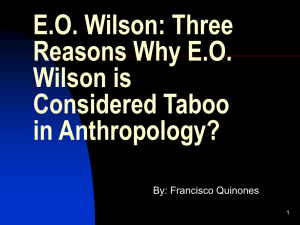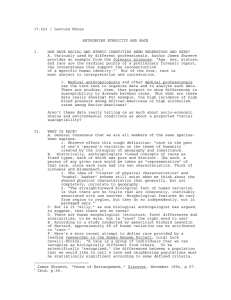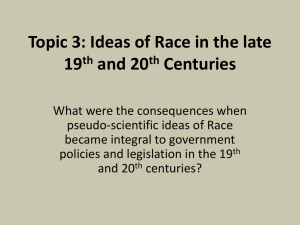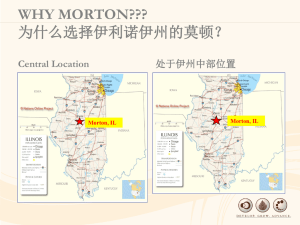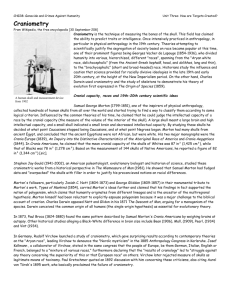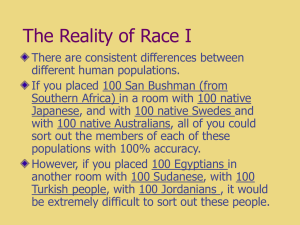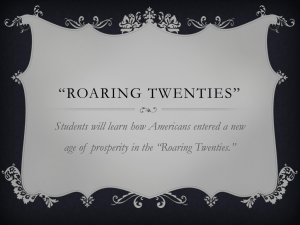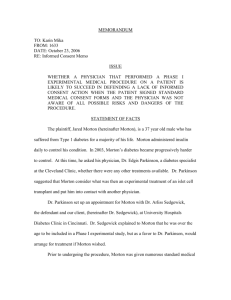Jim Crow Lesson Eugenics PowerPoint
advertisement
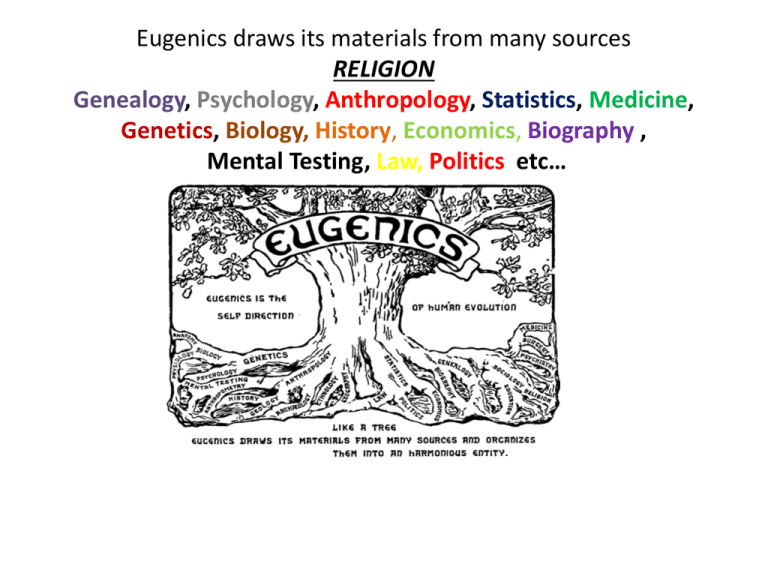
Eugenics draws its materials from many sources RELIGION Genealogy, Psychology, Anthropology, Statistics, Medicine, Genetics, Biology, History, Economics, Biography , Mental Testing, Law, Politics etc… What is Eugenics? It comes from a Greek word meaning “good in birth” or “noble in heredity.” • • • Eugenics is the study of or belief in the possibility of improving the qualities of the human species or a human population, especially by such means as discouraging reproduction by persons having genetic defects or presumed to have inheritable undesirable traits (negative eugenics) or encouraging reproduction by persons presumed to have inheritable desirable traits (positive eugenics). It was developed by Charles Darwin’s cousin, Francis Galton. Galton claimed that Eugenics would “raise the present miserably low standard of the human race” by “breeding the best with the best.” The Eugenics movement focuses on a time in the early 1900’s when many people believed that some “races”, classes, and individuals were superior to others. They used a new branch of scientific inquiry know as eugenics to justify their prejudices and advocate programs and policies aimed at solving the nation’s problems by ridding society of “inferior racial traits.” RACE • What are inferior and superior racial traits? • The following slides will give a snapshot of how Europeans and Americans formed their ideologies about “race superiority” in the 18th and 19th century through bias, careless, misinterpreted , & distorted data. • These ideologies were taught by “intellects” in prestigious universities in Europe and America. These ideologies (scientists) inspired the Framer’s of the Eugenics Movement in the 20th century. Johann Friedrich Blumenbach (May 11, 1752 – January 22, 1840) was a German physician, physiologist and anthropologist • In 1795, Johann Friedrich Blumenbach came up with a classification scheme. In his book, On the Natural Variety of Mankind, he divided humanity into five varieties. 1) 2) 3) 4) 5) • He associated humanity with a particular geographic area: Negro (African), Mongolian (Asian), Malay (Southeast Asia), American Indian (American), and Caucasian (European). Blumenbach introduced the word Caucasian “to describe the variety of mankind—the Georgian—that had originated on the southern slopes of Mount Caucasus.” This, to Blumenbach, was the first and most beautiful race, and he said it must be “considered as the primate or intermediate of these five principal races.” Other races represented “a degeneration from the original type.” 2 Petrus Camper (May 11, 1722 – April 7, 1789 ) was a Dutch physician, anatomist, physiologist, midwife, zoologist, anthropologist, paleontologist and a naturalist • Like Blumenbach, Petrus Camper was also preoccupied with the idea of beauty and order in the world. Trained as an artist before turning to science, Camper was a professor of anatomy at the University of Groningen in the Netherlands. His interest in art and anatomy came together in the illustration which originally appeared in a medical textbook printed in 1791 (see next slide), two years after his death. He believed that an organism’s “outer state”—its appearance—reflected its “inner state,” its moral or intellectual worth. He also believed in comparing animals to the human species. Convinced that ancient Greece and Rome had come closer than other civilizations to perfection, he used Greek statues to establish standards of beauty. He ranked human faces by how closely they resembled this ideal. After measuring dozens of Greek statues, Camper found that their “facial angle” averaged 100 degrees. (The facial angle is the angle formed by two intersecting lines—one drawn horizontally from the ears to the nose and other formed by the shape of the face from the upper lip to the forehead. See illustration, on next slide.) With this ideal in mind, Camper began measuring and sorting the skulls of apes and humans. • • • • He found : That apes had a facial angle of 42 to 50 degrees. The average for the Europeans he measured was about 90 degrees and for Africans 70 degrees. (The intersecting lines on the drawing below indicate “facial angles.”) • Concluding, African’s skull measurements are closer to the size of apes. Camper’s Progression of skulls and facial expressions- from (1st) monkey through (2nd) black, to the average (3rd) European and then thence to the (4th) Greek ideal-type” Samuel George Morton (1799–1851) was an American physician and natural scientist • George Morton a professor of medicine at the University of Pennsylvania, held two medical degrees and served as president of the Academy of Natural Sciences. • In the mid 19th century Samuel Morton extended Camper’s work. Morton believed that intelligence is linked to brain size. He therefore tried to rank the races according to skull size. After measuring a vast number of skulls from around the world, he concluded that whites have larger skulls than other races and are therefore “superior.” He was not sure if blacks were a separate race or a separate species, but African descent are different from and inferior to whites. he did insist that people of Morton’s “Observations on the size of the Brain in Various Races and families of Man.” The table below is taken from his research. Classification of races in Crania Americana In Crania Americana Morton divides humankind primarily into four races with the following characteristics: • Europeans • "The Caucasian Race is characterized by a naturally fair skin, susceptible of every tint; hair fine, long and curling, and of various colors. The skull is large and oval, and its anterior portion full and elevated. The face is small in proportion to the head, of an oval form, with well-proportioned features. . . . This race is distinguished for the facility with which it attains the highest intellectual endowments. . . . The spontaneous fertility of [the Caucasus] has rendered it the hive of many nations, which extending their migrations in every direction, have peopled the finest portions of the earth, and given birth to its fairest inhabitants. . . .“ • Asians • "This great division of the human species is characterized by a sallow or olive colored skin, which appears to be drawn tight over the bones of the face; long black straight hair, and thin beard. The nose is broad, and short; the eyes are small, black, and obliquely placed, and the eyebrows are arched and linear; the lips are turned, the cheek bones broad and flat. . . . In their intellectual character the Mongolians are ingenious, imitative, and highly susceptible of cultivation [i.e. learning]....So versatile are their feelings and actions, that they have been compared to the monkey race, whose attention is perpetually changing from one object to another....“ • • • • Native Americans "The American Race is marked by a brown complexion; long, black, lank hair; and deficient beard. The eyes are black and deep set, the brow low, the cheekbones high, the nose large and aquiline, the mouth large, and the lips tumid [swollen] and compressed. . . . In their mental character the Americans are averse to cultivation, and slow in acquiring knowledge; restless, revengeful, and fond of war, and wholly destitute of maritime adventure. They are crafty, sensual, ungrateful, obstinate and unfeeling, and much of their affection for their children may be traced to purely selfish motives. They devour the most disgusting [foods] uncooked and uncleaned, and seem to have no idea beyond providing for the present moment. . . . Their mental faculties, from infancy to old age, present a continued childhood. . . . [Indians] are not only averse to the restraints of education, but for the most part are incapable of a continued process of reasoning on abstract subjects. . . .“ Africans "Characterized by a black complexion, and black, woolly hair; the eyes are large and prominent, the nose broad and flat, the lips thick, and the mouth wide; the head is long and narrow, the forehead low, the cheekbones prominent, the jaws protruding, and the chin small. In disposition the Negro is joyous, flexible, and indolent; while the many nations which compose this race present a singular diversity of intellectual character, of which the far extreme is the lowest grade of humanity. . . . The moral and intellectual character of the Africans is widely different in different nations. . . . The Negroes are proverbially fond of their amusements, in which they engage with great exuberance of spirit; and a day of toil is with them no bar to a night of revelry. Like most other barbarous nations their institutions are not infrequently characterized by superstition and cruelty. They appear to be fond of warlike enterprises, and are not deficient in personal courage; but, once overcome, they yield to their destiny, and accommodate themselves with amazing facility to every change of circumstance. The Negroes have little invention, but strong powers of imitation, so that they readily acquire mechanic arts. They have a great talent for music, and all their external senses are remarkably acute." Morton’s ranking of the “races” had very real consequences. Louis Agassiz a noted biologist & professor at Harvard University, taught his students that Africans are a separate species. He also trained virtually all prominent U.S professors of natural history during the second half of the 19th century. Morton’s rankings also shaped the way many politicians, journalist, and ministers viewed two of the most pressing social and political issues of the day: the expulsion of the Native Americans from their ancestral lands and the expansion of Slavery. Between 1816 & 1850, over 100,000 Indians from 28 tribes were forced from their homes east of the Mississippi to western lands that white Americans considered useless. 3.5 million African Americans were slaves. Morton’s writing played a part in both debates by promoting the idea that the Constitution does not apply to Native Americans or Africans because they are not the sons of people for whom the document was written. Plessy v. Ferguson 1896 • One of the major consequences of “ranking the races” was reflected in the Plessy v. Ferguson court decision. The race ideologies taught in universities was practiced by intellects in our judicial system. • Associate Justice Henry B. Brown mirrored Samuel Morton’s ideas in his majority opinion. • Brown asserted, “If one race be inferior to the other socially, the Constitution of the United States cannot put them on the same plane.” • The Supreme Court, the highest law of the land, validated Morton’s ideas. Horrific Impact • The impact of the Plessy v. Ferguson court ruling had a profound impact on the lives of African Americans for decades. • The ruling cultivated the growth of a system of state and local legislation know as Jim Crow laws. Jim Crow established racial barriers in almost every aspect of American life. In many places, blacks and white Americans could not publicly sit, drink, or eat side by side. The military, schools, theatres, parks, public transportation were legally segregated. Resistance • Many people silently resisted “Jim Crow.” However, there were individuals who profusely spoke out against Jim Crow laws. • In the climax of the Eugenics Movement, audacious black soldiers in the United States military during World War II voiced their resistance in letters. • One of many was Corporal Rupert Trimmingham. Corporal Rupert Trimmingham • In the 1940s, the segregation of African Americans was not limited to civilian life. About 909,000 black Americans served in the Army during WWII, but most of these recruits were assigned to support details because military leaders questioned their ability to perform effectively in combat. • (see letter attachment) Corporal Rupert Trimmingham illuminates the manifestation of Jim Crow in the military. He highlights that the “Aryan” German prisoners of war were given more respect than African American citizens and Jews. Corporal Trimmingham writes the letter in 1944. One may find disturbing that the U.S government was fully aware of the enormity of the Nazi atrocities toward European Jews. • How could an American soldier sit at a table with war prisoners that directly or indirectly slaughtered millions of innocent European civilians?
